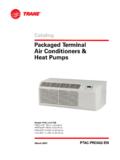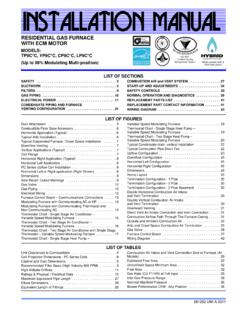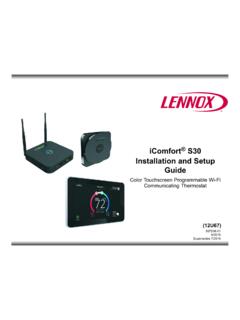Transcription of HVACR Troubleshooting Fundamentals
1 Jim Johnson HVACR Troubleshooting Fundamentals Refrigeration & Air Flow Systems HVACR Troubleshooting Fundamentals Refrigeration & Air Flow Systems Jim Johnson Library of Congress Cataloging-in-publication Data Johnson, Jim HVACR Troubleshooting Fundamentals : Refrigeration & Air Flow Systems ISBN-13: 978-1-937659-12-7 ISBN-10: 1-937659-12-7 2018 The MIE Instutute PO Box 2259 Green Valley, AZ 85622-2259 ALL RIGHTS RESERVED. No part of this work covered by the copyright herein may be reproduced, transmitted, stored or used in any form or by any means graphic, electronic, mechanical, including but not limited to photocopying, recording scanning digitizing, taping, Web distribution, information networks, or information storage and retrieval systems, except as permitted under Section 107 and 108 of the 1976 Copyright Act, without the prior written permission of the publisher.
2 Notice To The Reader The author and publisher do not warrant or guarantee any of the products described herein. The author and publisher do not assume, and expressly disclaims, any obligation to obtain and include any information other than that provided by the manufacturer. The reader is expressly warned to consider and adopt all safety precautions that might be indicated by the activities indicated herein and to avoid all potential hazards. By following the instructions described herein, the reader willingly assumes all risks in connection with such instructions.
3 The author and publisher make no representations or warranties of any kind, including but not limited to, the warranties of fitness for particular purpose or merchantability, nor are any such representations implied with respect to the material set forth herein, and the author and publisher take no responsibility with respect to such material. HVACR Troubleshooting Fundamentals Refrigeration & Air Flow Systems CONTENTS List of SECTION ONE: REFRIGERATION Fundamentals Unit 1 Heat The British Thermal Understanding Sensible & Latent Heat Unit 2 Refrigeration System Components and Accessories.
4 18 Metering Filter Heat Line Liquid Line Receivers Unit 3 The Refrigeration Simplified Refrigeration Refrigerant Temperature & High Pressure and Low Pressure In Refrigeration Purpose of Evacuation In Refrigeration Systems Unit 4 Superheat & The 70-Pound The 30- Degree Refrigerants and Oils.
5 Comparing R-22 & Refrigerant Flammability and Simplifying Superheat In Refrigeration Questions and Answers About Employing Superheat In A Manufacturer s Charging Evaporator Total Superheat In A Refrigeration Discharge Subcooling In Refrigeration Fundamental diagnostics Related To Refrigeration System Pressures Unit 5 Evacuation and Vacuum and Microns & Micron Vacuum Pump maintenance & Operation Unit 6 Accessing Refrigeration Systems For Refrigerant Recovery &
6 Accessing Small Refrigeration Schrader Schrader Valve Core Removal Quick Connect Compressor Mounted Access Liquid First Refrigerant Recovery Manifold Gauge Set Refrigerant Recovery Drum Push/Pull Refrigerant Non-Condensable Materials and Cooling A Recovery System Evacuation & Removing Moisture SECTION TWO.
7 AIR FLOW & HVACR EQUIPMENT EVALUATION Unit 7 Properties of Air & Fundamental Air Flow Air Density & Specific The and Multiplier Air Flow Measurement: CFM & Using FPM To Calculate Air Flow Calculations & Load Estimating Unit 8 Psychrometric Fundamentals of Psychrometrics.
8 DB WB & Structure of the Psychrometric Calculating RH & Wet Bulb Dew Common Properties of Air Unit 9 Supply & Return Air System Air Flow & TD Through A Free Blowing DX Air Flow Through A Forced Air Air Flow Fundamentals of Ducted Supply Duct Systems & Return Duct Systems & TEL Unit 10 HVACR System Air Flow System Supply Air Flow Return Air Manufacturer s Blower Performance Static Pressure Dry Bulb & Wet Bulb Temperature
9 Temperature Blower Door Duct Leakage Appendix A Troubleshooting i Preface For technicians, it s always about Troubleshooting . Most of the time, it s a very direct situation. A customer calls and says, My air conditioner is running but the house is warm or, Our walk-in is running at 55 degrees or, the information you get may be in simple, two-word sentences: No heat , No ice , Not running . In some cases, you may be called on to perform preventive maintenance , but that s still Troubleshooting .
10 You re evaluating the performance of the equipment, checking components to determine whether or not they may be potential problem, and comparing the actual results you re getting from your tests to what you know to be the normal operating characteristics or manufacturer s specifications of the equipment. Or, you may be tasked with accomplishing an equipment installation, which is also a form of Troubleshooting . If the installation isn t done right, then the system can t perform as it is designed to, and a problem will have to be solved before that equipment will be able to transfer heat properly, move air properly, or make the correct size of ice cubes.







